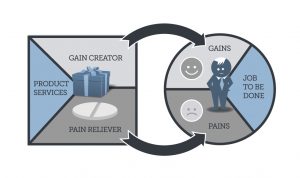The Fifty Shades of Value Propositions
 The term “value proposition” dates back to the 1980’s where we worked on the feature -> benefit -> advantage chains translating what we did into value for our customers. By the end of the last century, it had become a phrase we regularly used alongside the phrase “business model.”
The term “value proposition” dates back to the 1980’s where we worked on the feature -> benefit -> advantage chains translating what we did into value for our customers. By the end of the last century, it had become a phrase we regularly used alongside the phrase “business model.”
We owe it to Alexander Osterwalder who refined the definitions in his book Business Model Generation and later in his second book Value Proposition Design. These two books will bring you a long way to understanding what a value proposition is and how you design or refine it.
Nailing the value proposition (being attractive and competitive) is still the hardest part of developing a business and especially in the B2B domain executives are struggling. One of the reasons that many executives have such difficulties is related to the situational nature of the value of their products and services. The value of what they offer differs substantially from case to case.
Customer Value Promise
When you look at your total market, all you can do is make some general assumptions about the challenges and needs that your potential customers are facing, but you don’t know if they all face these issues and to which degree. Your customer value proposition, therefore, becomes very broad and vague and doesn’t appeal to anyone. You use value propositions promising higher productivity, better overview, or improved competitiveness. So do your direct competitors, and your potential clients are also exposed to the same value propositions from investment opportunities in completely different areas, too.
Customer Value Suggestion
As you research the individual potential client and learn more about their situation, you may be able to come up with a customer value suggestion, but it isn’t until you have access to key people in the client’s organization that you can discover a meaningful customer value proposition. And it doesn’t become a value proposition until the client agrees.
The Customer Contribution
 When it comes to B2B software, two major non-product related areas determine the value.
When it comes to B2B software, two major non-product related areas determine the value.
1. The services required to customize, implement and support the software.
2. The client’s ability to prepare and motivate his organization to accept and use the software.
Customers with almost identical demographic characteristics can derive completely different levels of value from the same software depending on their ability to manage the changes and on the quality of the vendor’s services.
In such situations, it makes no sense to come up with broad and general value promises assuming that all the other critical elements of the full delivery will be perfect. Potential clients know very well that it takes more than the software to release the value. You have to face the challenges and explain how you address them. Selling B2B software solutions is about defining and designing the path to project success including mitigating the risk of failure. The better you can help mitigate the risk the more likely you will win the business.
–ooOoo–
You will want to read this whitepaper:








